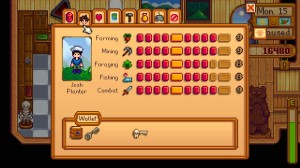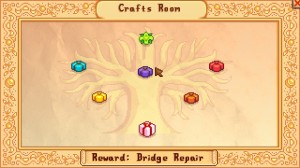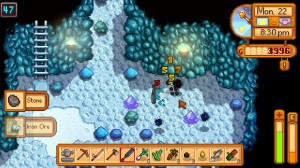Stardew Valley is the passion project from Eric Barlone and his attempt at replicating and growing the addictive gameplay of the Harvest Moon and Rune Factory series on the PC. After four years of work, the game is finally out and gives us one of my favorite games of 2016.
Getting Away from it All:
The story of Stardew Valley is that you have been left the deed to a farm in Stardew Valley by your late grandfather. Upon arriving, you find a delightful town full of life and a dilapidated farm to call your own. From there, it’s up to you to decide how you want to spend your time and grow in Stardew Valley.
For people not familiar with the Harvest Moon games, the series is all about a casual atmosphere where the player can decide what they want to do at any given moment. While advanced play is focused on optimizing time and farm space, you are never really punished in the long run for any mistakes.
Each day, you’ll have to manage your energy and dedicate it to the tasks of running your farm and doing extra activities. You can go into town to talk to the people, give gifts and buy supplies and upgrades that you can use to make your farm better. Besides the farm, you can date the locals, mine, fish and more. The gameplay is kept pretty basic, with one button for using tools and one for interacting; this is not the game for simulation levels of farming.
As you continue doing the various tasks of the game, you’ll level up in those fields; making it easier to do them and unlock new content for them.
The content and progression model of Stardew Valley are the best parts of the game and where it really does go above and beyond the Harvest Moon series.
Working the Land:
Stardew Valley may be a casual experience, but it features some intelligently designed gameplay with a great progression model. There are two main resources that lock content from you: Money and materials. In order to purchase upgrades, new equipment and make your farm bigger, you need to earn enough money to buy them and materials.
Every task that you can do in the game will give you money, be it farming and selling crops, fishing, mining ore etc; the majority of the resources needed for upgrades can be found while doing tasks or simply by spending money. Because money is the main factor in what you can and can’t do, it makes it so that everything that you do while playing will work towards progressing.
It’s a great progression model and presents a positive feedback loop that makes Stardew Valley very hard to put down; you’re always one day away from something new which in turn unlocks something else. Since you level up in the tasks that you keep on doing, it further gives you more options and reasons to play.
Besides that, the game gives you short and long-term goals to help focus your play and give you a tangible goal to pursue other than just getting a bigger farm.
And once again, that positive feedback loop keeps you coming back for more.
Stardew Valley is an amazing game and one that is very hard for me to find fault with; my only problems are of the nitpick and annoyance variety.
Bugs in the Field:
Stardew Valley is a great but polarizing game; not because the game is controversial, but because of how it was designed. The game is meant to be a spiritual successor/elevated take on the Harvest Moon style gameplay. You are either going to love Stardew Valley or put it down after one play; there is no in-between.
This kind of game experience is a new thing for the PC audience and may be considered too limited for people expecting challenging gameplay. Again, the casual and open experience is a major draw of the game and part of the appeal, but it also makes the game very repetitive; going back to either loving or hating it. While there are some advanced challenges, they’re all built around the same gameplay and that sense of grinding out the resources needed to get the job done.
From a design standpoint, I already talked about my love of the options in-game and the progression model, the only legitimate problem I have is with the UI. Eric went with a one size fits all design of the game’s UI; with each system using the same inventory, control scheme and implementation.
The problem is that it leads to things feeling more cumbersome than what they should be. I had to play inventory musical chairs multiple times to try and get the right items I want to use at a given moment.
The game uses cursor position for some actions like farming, but seems to ignore it for combat. If it would be possible, some kind of a smart UI would be helpful and more intuitive, but that may be too much of a change for the game.
At the moment Eric is still working on Stardew Valley and promises more endgame content and additions with patches.
Blue Ribbon:
Stardew Valley is an amazing game for fans of a series that we don’t see on the PC. As I’ve said, if it gets its hooks in you, this is a game that you can play and love for a very long time. For more on Stardew Valley, you can check my growing playlist of videos as I attempt to balance farm life, love life and adventuring all at once.





